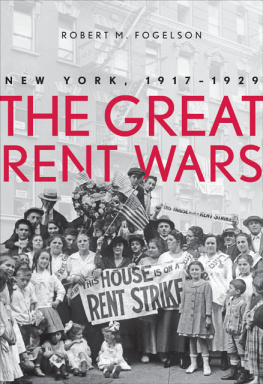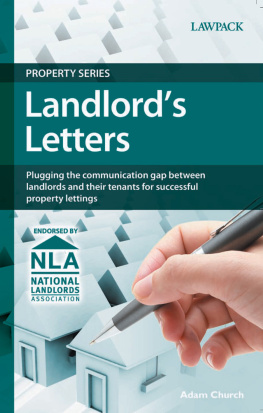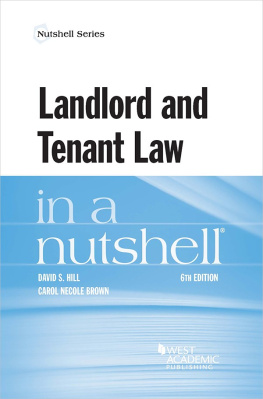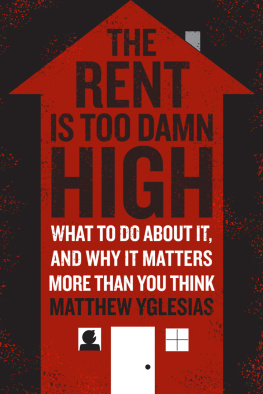THE GREAT RENT WARS


Copyright 2013 by Robert M. Fogelson.
All rights reserved.
This book may not be reproduced, in whole or in part, including illustrations, in any form (beyond that copying permitted by Sections 107 and 108 of the U.S. Copyright Law and except by reviewers for the public press), without written permission from the publishers.
yalebooks.com/art
Designed by Nancy Ovedovitz.
Set in Swift Light type by IDS Infotech, Ltd.
Printed in the United States of America.
Library of Congress Cataloging-in-Publication Data
Fogelson, Robert M.
The great rent wars : New York, 19171929 / Robert M. Fogelson.
pages cm.
Includes bibliographical references and index.
ISBN 978-0-300-19172-1 (alk. paper)
1. Rent controlNew York (State)New YorkHistory20th century. I. Title.
KFX2085.R3F64 2013
346.747 104344dc23 2012048964
A catalogue record for this book is available from the British Library.
This paper meets the requirements of ANSI/NISO Z39.481992 (Permanence of Paper).
10 9 8 7 6 5 4 3 2 1
To Nancy Kirk, Duncan Kincaid, and Maria J. Fuente
CONTENTS
PROLOGUE
On January 9, 1918, barely a week after taking office, Mayor John F. Hylan declared that New York was facing the worst crisis in its history. With more than two months of winter ahead, the city was running out of coal, the fuel that supplied nearly all its heat, light, and power. A coal shortage was not something New Yorkers ordinarily worried about. But in April 1917 the United States had entered World War I. Seven months later, after the first cold snap of the season, many landlords found that they had very little coal in their cellars and, wrote the New York Call, the city's Socialist newspaper, no idea where the next lot of fuel is coming from. We are in no position to deliver what we haven't got, said one coal dealer. Holding on to wooden carts and baby carriages lined with newspapers, housewives lined up at dawn to wait for the opening of coal offices and to plead with distracted dealers for a few pounds of the precious fuel. All too often they were still waiting when the dealers posted the sign No more orders taken. By mid-December the city's coal supply was dangerously low, wrote the Call. What, it asked, can be said of a social and commercial system that will bring [New York] face to face with the first great snowstorm of the winter with empty coal bins? By the end of the year a spokesman for the Retail Coal Dealers Association warned that the city had less than one day's supply on hand. Fully one-third of the city's apartment houses had no coal at all. The situation is as bad as it has ever been, wrote the counsel for the Greater New York Coal Dealers in early February. New York was on the verge of a complete fuel famine, warned the Call.
Hylan's claim notwithstanding, the coal shortage was not the worst crisis in the city's history. It was not as bad as the cholera epidemic of 1849, much less the yellow fever outbreak of 1798, which had carried off nearly 5 percent of the population. But it was bad enough. As the temperature fell in the winter of 1918, many New Yorkers found themselves with little or no heat and hot water. Life in the tenements was
For most New Yorkers the new year was anything but happy. As the Call wrote:
Up from the tenements, with the accumulation of dust and dirt and their defenselessness against the icy blasts of winter, the cry is swellingCoal! Up from the houses of the middle-class comes the echoCoal! And now from even the inhabitants of the apartments of Riverside Drive, West End Avenue, and other thoroughfares of the well-to-do, and the rich, the cry is commencing to be heardCoal!
But there was so little coal that before long, the city was taking steps that would once have been unthinkable. Several high schools sent students home, as did dozens of elementary schools. Some settlement houses closed, and a few hospitals were on the verge of shutting down. Subways, els, and streetcars ran without heatand, in some cases, stopped running. A few criminal courts shut down as well. Manhattan District Attorney Edward Swann and his staff read by candlelight. And inmates of the Tombs, an old prison in Lower Manhattan, were wrapped in blankets and sent to bed. To conserve fuel, office buildings banked their fires and turned off the lights at 7:00 p.m. on weekdays and 3:00 p.m. on Saturdays. Employees of Chase Manhattan Bank, one of Wall Street's leading financial institutions, worked in overcoats. Hotels, clubs, and restaurants shut off outside lights. Even the Waldorf-Astoria, a Midtown Manhattan hotel that catered to the very wealthy, urged guests to turn off the lights when leaving the rooms. In addition to meatless and wheatless days, two wartime innovations of U.S. Food Administrator (and future president) Herbert C. Hoover, New Yorkers now had to get used to lightless nights.
For as long as most Americans could remember, coal had been plentiful. And it remained so even after the European powers went to war in August 1914. Although the demand for coal rose steadily, so did the supply, which increased by more than one-third over the next two and a half years. But after the United States entered the war, the mines could not keep up with the soaring demand. With the American military mobilizing and the American economy booming, the mines could not supply enough coal to keep the nation's railroads, ships, and factories running, much less to keep its homes and shops warm and well lit. To make matters worse, the railroads were hard-pressed to carry the coal from the mines to the cities. The rail systemif system is an appropriate word for the hodge-podge of companies that ran the trainscould not cope with the sudden 50 percent increase in orders. So severe was the shortage of rolling stock, the result in part of the Wilson administration's decision to push American manufacturers to supply sorely needed locomotives and cars to France and Russia, and so monumental were the traffic jams, that in the summer and fall of 1917 some mines closed because they could not get the coal to the market. The situation became so grave that in late December the federal government took control of the railroads, placing them in the hands of the U.S. Railroad Administration, which was headed by Treasury Secretary William G. McAdoo.
By the time the Railroad Administration began work, winter had arrived in the Northeast and Midwest. And what a winter it was. Early in December the temperature in New York fell to ten degrees. It was so cold, reported the Times, that the few
The arctic weather did more than increase the demand for coal. It also reduced the supply. Ordinarily it took twenty-one days to get coal from the mines to the yards. But not this winter. As engines, switches, and water stations froze and tracks were buried under snowbanks three and four feet high, traffic came to a standstill for days at a time over much of the Northeast and Midwest. When the trains finally arrived at the terminals in New Jersey, the coal was often frozen solid and covered with snow, wrote the Times. It had to be thawed out before it could be dumped into barges and brought to the city. From the docks in Jersey City, Bayonne, and South Amboy to the yards in Manhattan and Brooklyn was less than a mile. But with much of New York harbor clogged with icemore ice, said shippers and seamen, than at any time in the past thirty yearsit was too risky for tugboats and barges to make the trip. Dozens of vessels were already caught in the floes. Finally, with tugs and other ships provided by the railroad companies and the U.S. Navy, efforts were made to break through the ice. In early January, for example, four tugs, linked by a giant hawser, opened a one-hundred-foot channel that allowed 100,000 tons of coal to be shipped from the Reading Railroad's terminals in South Amboy. But it was hard going. In early February, after yet another bout of frigid weather, so much ice piled up in the harbor that there was a practical embargo on shipping, wrote the
Next page











